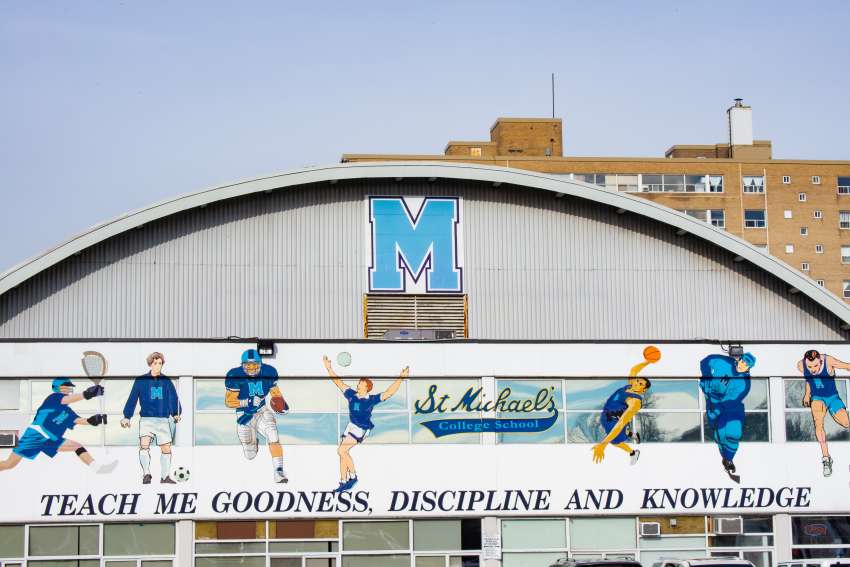It’s never been entirely true, as it is often the coverup that constitutes new crimes. But the point remains. A “third-rate burglary” brought down a president because he covered it up rather than allowed justice to be done.
That adage has been applied now for some time in the Catholic sexual abuse scandals. Indeed, it is not unusual for the lion’s share of attention to be given not to the victim and his or her story, nor to the perpetrator and his crimes, but rather to the superiors and their actions.
The Watergate question is often the only question that gets asked: “What did the bishop/pastor/principal know and when did he know it?”
The situation of St. Michael’s College School allows to see that media dynamic in action. That story is moving fast with new developments, including an “independent examination” of the culture of the school which was announced on Sunday, Nov. 18. The next day, six students were arrested and charged with sexual assault.
The facts of the cases brought to light, and subsequent criminal action, will be better known in the days and weeks ahead. My limited intention here is to examine how the media covered the story.
And we find something familiar. The story is not covered incorrectly, but incompletely. More to the point, the story is primarily about secondary things.
An assault story is primarily about the one assaulted and those alleged to have done the assaulting. It is also a story about the consequences of that and the pursuit — or lack thereof — of justice.
Yet bad habits have crept into press coverage of sexual abuse stories, so that the secondary angle becomes the dominant angle. We saw that in the St. Mike’s story.
The primary story at St. Mike’s was that apparent “hazing” rituals on the sports teams subjected boys to humiliating behaviour – the “washroom” incident — and to degrading, violent behaviour of sexual nature — the “locker room” incident.
For a journalist, the story ought to be what happened, who was involved, and why it took place. Related questions certainly arise: Is this common, or unusual at St. Mike’s? At high schools in general? What might explain why what happened took place?
To be fair, this story is not easy to cover, particularly when those involved are teenagers, and not easy to reach for interviews.
That being conceded, it was a journalistic failure to put the school administration at the centre of the story. The “coverup” default was in firmly in place.
The Toronto Star headline was clear: “St. Mike’s did not report alleged sexual assault video to police, Toronto police say.”
The National Post took the same line: “School didn’t report alleged assault: Cops.”
The story was about how the school covered-up the incidents. Did it?
On Monday, Nov. 12, the school administration receives the video about it washroom incident. It contacts the police to ask for advice on how to proceed. It investigates by interviewing students and their parents. That was all on the first day.
That evening, the other, most serious video comes to the school administration’s attention.
On Tuesday, faculty and staff at the school are notified of both videos and investigations into both continue. Four students from the washroom incident are expelled.
On Wednesday, investigation of the locker room video continues. Four more students are expelled and their families are notified that police will be contacted by the school.
Apparently the police contacted the school first, having heard about the second video from other sources. Still on Wednesday, the school provides the video and related information to the police.
Is this plausibly a coverup story? When the school contacted police the very day they received the first video? And within 48 hours of receiving the second video it was in the hands of the police? And in the intervening period eight students had been expelled?
It can be argued that, when the school received the second video, it should have notified police immediately.
That is how the first video was treated, and the police have said the second should have been handled the same way. But as the principal subsequently explained, the boy assaulted in the second video had not told his parents and the principal wanted him to have a chance to do so before the police showed up at his door to investigate. There is no reason to doubt that, nor to say that the principal should be more concerned with what media critics might say about him than the welfare of the student and his family.
To present as a “coverup” a 48-hour period in which police were contacted more than once, evidence was turned over and internal discipline applied, requires the facts to be forced into a pre-existing storyline.
It may be that we will discover more that justifies the “coverup” angle. All I know is what I have read in the media. But what is there does not justify the default angle of “coverup”.
Sexual assault — all the moreso when it takes place in a Catholic parish or school — deserves serious media coverage. It is lazy journalism to fall back on default positions which do not apply.
(Fr. de Souza is editor-in-chief of Convivium.ca and a pastor in the Archdiocese of Kingston.)

